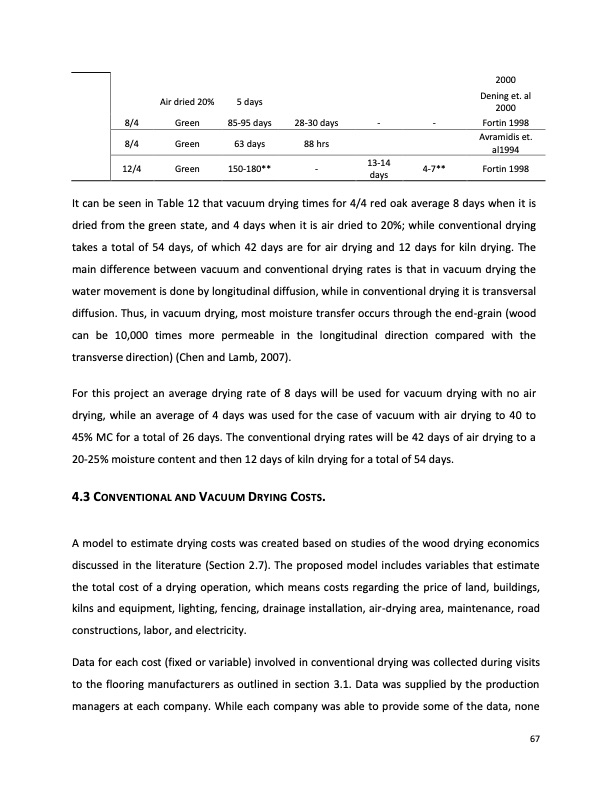
PDF Publication Title:
Text from PDF Page: 077
8/4 8/4 12/4 Air dried 20% Green Green Green 5 days 85-95 days 63 days 150-180** 28-30 days 88 hrs - - - 13-14 4-7** days 2000 Dening et. al 2000 Fortin 1998 Avramidis et. al1994 Fortin 1998 It can be seen in Table 12 that vacuum drying times for 4/4 red oak average 8 days when it is dried from the green state, and 4 days when it is air dried to 20%; while conventional drying takes a total of 54 days, of which 42 days are for air drying and 12 days for kiln drying. The main difference between vacuum and conventional drying rates is that in vacuum drying the water movement is done by longitudinal diffusion, while in conventional drying it is transversal diffusion. Thus, in vacuum drying, most moisture transfer occurs through the end-grain (wood can be 10,000 times more permeable in the longitudinal direction compared with the transverse direction) (Chen and Lamb, 2007). For this project an average drying rate of 8 days will be used for vacuum drying with no air drying, while an average of 4 days was used for the case of vacuum with air drying to 40 to 45% MC for a total of 26 days. The conventional drying rates will be 42 days of air drying to a 20-25% moisture content and then 12 days of kiln drying for a total of 54 days. 4.3 CONVENTIONAL AND VACUUM DRYING COSTS. A model to estimate drying costs was created based on studies of the wood drying economics discussed in the literature (Section 2.7). The proposed model includes variables that estimate the total cost of a drying operation, which means costs regarding the price of land, buildings, kilns and equipment, lighting, fencing, drainage installation, air-drying area, maintenance, road constructions, labor, and electricity. Data for each cost (fixed or variable) involved in conventional drying was collected during visits to the flooring manufacturers as outlined in section 3.1. Data was supplied by the production managers at each company. While each company was able to provide some of the data, none 67PDF Image | Impact of Vacuum-Drying on Efficiency of Hardwood Products

PDF Search Title:
Impact of Vacuum-Drying on Efficiency of Hardwood ProductsOriginal File Name Searched:
Brenes_Angulo_OM_T_2014.pdfDIY PDF Search: Google It | Yahoo | Bing
5,000 BF Shipping Container Lumber Dry Kiln For Quality Lumber The 5,000 BF container kiln consists of one 40 foot high-cube aluminum shipping container... More Info
Shipping Container Lumber Dry Kilns by Global Energy Global Energy designed and developed the container kiln back in 1991. The purpose is to give access to portable sawmill owners, furniture makers, and small business the value added profit of dry kiln lumber and quality hardwoods... More Info
Vacuum Kiln Conversion Kit for Lumber and Wood Dry Kilns Convert your existing conventional dry kiln into a fast drying vacuum kiln. Similar to vacuum bagging in the boat building and aircraft industry, we have come up with a proprietary process which allows you to build a very simple vacuum kiln at a fraction of the price, and without the intensive conventional metal chamber structure... More Info
Vacuum Pump Cart System for Bagging Clamping Wood Drying and more Vacuum Cart with 2HP Pump and Dual Pistons with multiple multiplex vacuum ports and liquid reservoir... More Info
Vacuum Bagging Basics Vacuum bagging is a method of clamping, which has traditionally been used in the composites industry, but can also be used for vacuum drying materials, including wood products... More Info
| CONTACT TEL: 608-238-6001 Email: greg@globalmicroturbine.com | RSS | AMP |